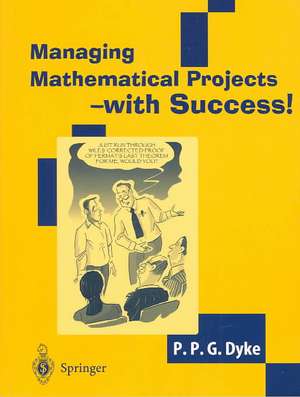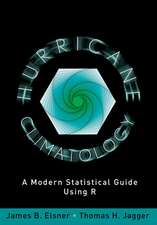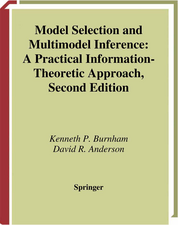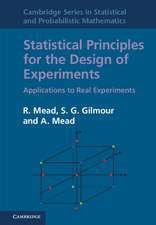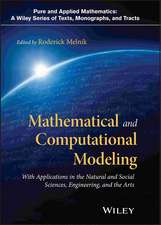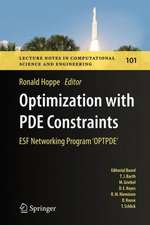Managing Mathematical Projects - with Success!
Autor P.P.G. Dykeen Limba Engleză Paperback – 19 ian 2004
Preț: 324.99 lei
Nou
Puncte Express: 487
Preț estimativ în valută:
62.21€ • 67.59$ • 52.29£
62.21€ • 67.59$ • 52.29£
Carte tipărită la comandă
Livrare economică 21 aprilie-05 mai
Preluare comenzi: 021 569.72.76
Specificații
ISBN-13: 9781852337360
ISBN-10: 1852337362
Pagini: 284
Ilustrații: XIV, 266 p.
Dimensiuni: 178 x 254 x 15 mm
Greutate: 0.49 kg
Ediția:2004
Editura: SPRINGER LONDON
Colecția Springer
Locul publicării:London, United Kingdom
ISBN-10: 1852337362
Pagini: 284
Ilustrații: XIV, 266 p.
Dimensiuni: 178 x 254 x 15 mm
Greutate: 0.49 kg
Ediția:2004
Editura: SPRINGER LONDON
Colecția Springer
Locul publicării:London, United Kingdom
Public țintă
ResearchCuprins
1. Introduction and Organisation
1.1 Individual Projects
1.2 Group Projects
1.3 Case Studies
2. Assessment
2.1 Introduction
2.2 Interim Reports
2.3 Verbal Presentations
2.4 Final Report
2.5 Moderating
2.6 Assessment of Case Studies
3. Individual Projects
3.1 Introduction
3.2 Selecting a Project
3.3 Report Writing
3.4 Non-Euclidean Geometry
3.4.1 Scope
3.4.2 Project Details
3.5 Boomerangs
3.5.1 Scope
3.5.2 Project Details
3.6 Hurricane Dynamics
3.6.1 Scope
3.6.2 Project Details
3.7 Hypergeometric Functions
3.7.1 Scope
3.7.2 Project Details
3.8 Summary
3.9 Project Examples
4. Group Projects
4.1 Introduction
4.2 Setting up Group Projects
4.2.1 Peer Assessment
4.2.2 Dividing into Groups
4.3 Estuarial Diffusion
4.4 Graphs and Networks
4.5 Fourier Transforms
4.6 Orbital Motion
4.7 Conclusion
4.8 Further Suggestions
5. Case Studies
5.1 Introduction
5.2 Ocean Surface Dynamics
5.3 Non-linear Oscillations
5.4 Traffic Flow
5.5 Contour Integral Solutions to ODEs
5.6 Optimisation
5.7 Euler and Series
5.8 Summary
5.9 Exercises
A. Project Example 1: Topics in Galois Theory
A.1 Galois' Approach
A.1.1 Preparation
A.1.2 The Galois Resolvent
A.1.3 The Galois Group
A.1.4 Soluble Equations and Soluble Groups
A.2 The Modern Approach
A.2.1 Field Extension
A.2.2 The Galois Group
A.2.3 Applying Galois Theory
A.3 Soluble Groups
A.3.1 Normal Subgroup Series
A.3.2 Normal Subgroups
A.3.3 Simple Groups
A.3.4 p-Groups
A.4 Geometrical Constructions
A.4.1 Constructible Points
A.4.2 Impossibility Proofs
A.4.3 Performing Algebraic Operations by Construction
A.4.4 Regular n-gons
B. Project Example 2: Algebraic Curves
B.1 Basic De.nitions and Properties
B.1.1 Complex Algebraic Curves and Real Algebraic Curves
B.1.2 Projective Spaces
B.1.3 A.ne and Projective Curves
B.1.4 Singular Points
B.2 Intersection of Two Curves and Points of Inflection
B.2.1 Bezout's Theorem
B.2.2 Points of Inflection on a Curve
B.3 Conics and Cubics
B.3.1 Conics
B.3.2 Cubics
B.3.3 Additive Group Structure on a Cubic
B.4 Complex Analysis
B.4.1 Holomorphic Functions and Entire Functions
B.4.2 Closed Curve Theorem and Line Integrals
B.4.3 Liouville's Theorem and Fundamental Theorem of Algebra
B.4.4 Properties of Holomorphic Functions
B.4.5 General Cauchy Closed Curve Theorem
B.4.6 Isolated Singularities and Removable Singularities
B.4.7 Laurent Expansions
B.4.8 Residue Theorem
B.4.9 Conformal Mapping
B.5 Topology and Riemann Surfaces
B.5.1 Topology of Complex Algebraic Curves
B.5.2 Riemann Surfaces
B.5.3 Degeneration of a Cubic
B.5.4 Singularities and Riemann Surfaces
B.6 Further Topics
B.6.1 The Weierstrass Function
B.6.2 Differential Forms on a Riemann Surface
B.6.3 Abel's Theorem
C. Project Example 3: Water Waves on a Sloping Beach
C.1 Abstract
C.2 Introduction
C.3 Surface Waves
C.3.1 The Current
C.3.2 The Boundary Conditions
C.3.3 A Separable Solution of Laplace's Equation
C.4 [No Title]
C.4.1 The Velocity of the Waves
C.4.2 The Group Velocity of the Waves
C.4.3 The Motion of the Particles
C.4.4 Breaking Waves in Shallow Water
C.5 [No Title]
C.5.1 Plane Waves
C.5.2 Wave Rays
C.5.3 The Waves Approaching a Beach
C.5.4 Wave rays in shallow water
C.6 [No Title]
C.6.1 Conclusion and Discussion
Index
1.1 Individual Projects
1.2 Group Projects
1.3 Case Studies
2. Assessment
2.1 Introduction
2.2 Interim Reports
2.3 Verbal Presentations
2.4 Final Report
2.5 Moderating
2.6 Assessment of Case Studies
3. Individual Projects
3.1 Introduction
3.2 Selecting a Project
3.3 Report Writing
3.4 Non-Euclidean Geometry
3.4.1 Scope
3.4.2 Project Details
3.5 Boomerangs
3.5.1 Scope
3.5.2 Project Details
3.6 Hurricane Dynamics
3.6.1 Scope
3.6.2 Project Details
3.7 Hypergeometric Functions
3.7.1 Scope
3.7.2 Project Details
3.8 Summary
3.9 Project Examples
4. Group Projects
4.1 Introduction
4.2 Setting up Group Projects
4.2.1 Peer Assessment
4.2.2 Dividing into Groups
4.3 Estuarial Diffusion
4.4 Graphs and Networks
4.5 Fourier Transforms
4.6 Orbital Motion
4.7 Conclusion
4.8 Further Suggestions
5. Case Studies
5.1 Introduction
5.2 Ocean Surface Dynamics
5.3 Non-linear Oscillations
5.4 Traffic Flow
5.5 Contour Integral Solutions to ODEs
5.6 Optimisation
5.7 Euler and Series
5.8 Summary
5.9 Exercises
A. Project Example 1: Topics in Galois Theory
A.1 Galois' Approach
A.1.1 Preparation
A.1.2 The Galois Resolvent
A.1.3 The Galois Group
A.1.4 Soluble Equations and Soluble Groups
A.2 The Modern Approach
A.2.1 Field Extension
A.2.2 The Galois Group
A.2.3 Applying Galois Theory
A.3 Soluble Groups
A.3.1 Normal Subgroup Series
A.3.2 Normal Subgroups
A.3.3 Simple Groups
A.3.4 p-Groups
A.4 Geometrical Constructions
A.4.1 Constructible Points
A.4.2 Impossibility Proofs
A.4.3 Performing Algebraic Operations by Construction
A.4.4 Regular n-gons
B. Project Example 2: Algebraic Curves
B.1 Basic De.nitions and Properties
B.1.1 Complex Algebraic Curves and Real Algebraic Curves
B.1.2 Projective Spaces
B.1.3 A.ne and Projective Curves
B.1.4 Singular Points
B.2 Intersection of Two Curves and Points of Inflection
B.2.1 Bezout's Theorem
B.2.2 Points of Inflection on a Curve
B.3 Conics and Cubics
B.3.1 Conics
B.3.2 Cubics
B.3.3 Additive Group Structure on a Cubic
B.4 Complex Analysis
B.4.1 Holomorphic Functions and Entire Functions
B.4.2 Closed Curve Theorem and Line Integrals
B.4.3 Liouville's Theorem and Fundamental Theorem of Algebra
B.4.4 Properties of Holomorphic Functions
B.4.5 General Cauchy Closed Curve Theorem
B.4.6 Isolated Singularities and Removable Singularities
B.4.7 Laurent Expansions
B.4.8 Residue Theorem
B.4.9 Conformal Mapping
B.5 Topology and Riemann Surfaces
B.5.1 Topology of Complex Algebraic Curves
B.5.2 Riemann Surfaces
B.5.3 Degeneration of a Cubic
B.5.4 Singularities and Riemann Surfaces
B.6 Further Topics
B.6.1 The Weierstrass Function
B.6.2 Differential Forms on a Riemann Surface
B.6.3 Abel's Theorem
C. Project Example 3: Water Waves on a Sloping Beach
C.1 Abstract
C.2 Introduction
C.3 Surface Waves
C.3.1 The Current
C.3.2 The Boundary Conditions
C.3.3 A Separable Solution of Laplace's Equation
C.4 [No Title]
C.4.1 The Velocity of the Waves
C.4.2 The Group Velocity of the Waves
C.4.3 The Motion of the Particles
C.4.4 Breaking Waves in Shallow Water
C.5 [No Title]
C.5.1 Plane Waves
C.5.2 Wave Rays
C.5.3 The Waves Approaching a Beach
C.5.4 Wave rays in shallow water
C.6 [No Title]
C.6.1 Conclusion and Discussion
Index
Recenzii
From the reviews:
"More than 20 years of the author’s experience in supervising and assessing mathematical projects have resulted in this book, the title of which can hardly be more eloquent. … The features of individual projects, group projects and case studies are carefully described … . It is a sheer joy reading it and appreciating the authors’ refined style and humor. From the viewpoint of students, supervisors, as well as of assessors, this book must be unanimously marked as excellent." (EMS Newsletter, September, 2005)
"The text does discuss fully the supervision and assessment of both pure and applied mathematics projects, and, for me personally, the level of detail on this aspect has been the most useful feature of the book. … Academic staff will certainly find this book relevant. For departments considering introducing final year projects based on mathematics, Managing mathematical projects gives invaluable guidelines. For departments already running such projects, the book is both useful and stimulating." (David Hood, The Mathematical Gazette, Vol. 91 (520), 2007)
"More than 20 years of the author’s experience in supervising and assessing mathematical projects have resulted in this book, the title of which can hardly be more eloquent. … The features of individual projects, group projects and case studies are carefully described … . It is a sheer joy reading it and appreciating the authors’ refined style and humor. From the viewpoint of students, supervisors, as well as of assessors, this book must be unanimously marked as excellent." (EMS Newsletter, September, 2005)
"The text does discuss fully the supervision and assessment of both pure and applied mathematics projects, and, for me personally, the level of detail on this aspect has been the most useful feature of the book. … Academic staff will certainly find this book relevant. For departments considering introducing final year projects based on mathematics, Managing mathematical projects gives invaluable guidelines. For departments already running such projects, the book is both useful and stimulating." (David Hood, The Mathematical Gazette, Vol. 91 (520), 2007)
Caracteristici
The first practical guide on how to make a success of project work and case studies in mathematics Provides an essential head-start for students and a useful resource for lecturers and project advisors looking for ideas on how to devise, assess and manage projects Includes extracts, with commentary, from past projects and case studies in pure and applied mathematics Includes supplementary material: sn.pub/extras
